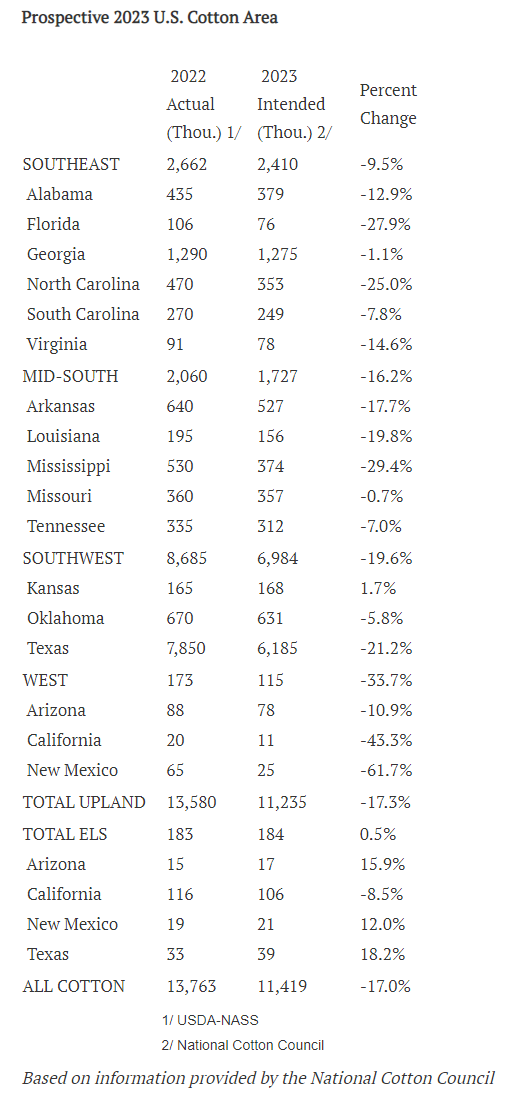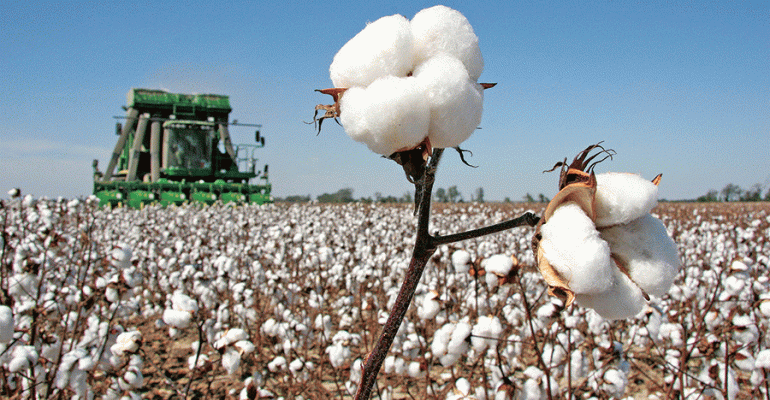U.S. cotton producers intend to plant 11.4 million cotton acres this spring, down 17% from 2022, according to the National Cotton Council’s 42nd Annual Early Season Planting Intentions Survey.
Upland cotton intentions are 11.2 million acres, down 17.3% from 2022, while extra-long staple (ELS) intentions of 184,000 acres represent a 0.5% increase.
The detailed survey results were announced Feb. 12 during the 2023 National Cotton Council Annual Meeting.
Dr. Jody Campiche, NCC Vice President, Economics & Policy Analysis, said, “Planted acreage is just one of the factors that will determine supplies of cotton and cottonseed. Ultimately, weather and agronomic conditions are among the factors that play a significant role in determining crop size.”
Using five-year average abandonment rates along with a few state-level adjustments to account for current dry conditions, projected Cotton Belt harvested area totals 8.8 million acres for 2023 with a U.S. abandonment rate of 22.6%. Using the five-year average state-level yield per harvested acre generates a cotton crop of 15.7 million bales, with 15.2 million upland bales and 466,000 ELS bales.
The NCC questionnaire, mailed in mid-December 2022 to producers across the 17-state Cotton Belt, asked producers for the number of acres devoted to cotton and other crops in 2022 and the acres planned for the coming season. Survey responses were collected through mid-January.
“History has shown that U.S. farmers respond to relative prices when making planting decisions,” noted Campiche. “Relative to the average futures prices during the first quarter of 2022, cotton prices are lower while the prices of most competing commodities are relatively unchanged. Price ratios of cotton to corn and soybeans are at the lowest level since planting the 2009 crop. In addition, production costs remain elevated.”
Southeast respondents indicate a 9.5% decline in cotton acreage to 2.4 million acres. In Alabama, the survey responses indicate a 12.9% decrease in cotton acreage to 379,000 acres. In Florida, respondents indicated 27.9% less cotton. Georgia growers expect to plant 1.1% less cotton, while the survey indicates a 25% decline in North Carolina’s cotton area. South Carolina growers expect to plant 7.8% less cotton, with Virginia growers reducing cotton acreage by 14.6%. According to the survey responses, the expected decline in cotton acres is due to an increase in corn, soybeans, wheat, and peanuts.
Mid-South growers intend to plant 1.7 million acres, a decline of 16.2% from the previous year. In Arkansas, acreage is expected to decline by 17.7%, while Louisiana growers expect to plant 19.8% less cotton. In Mississippi, cotton acreage is expected to decline by 29.4%. Missouri growers expect to plant 0.7% less cotton, while Tennessee acreage is expected to decline by 7% percent. Survey responses suggest an increase in corn, soybeans, wheat, and other crops.
Growers in the Southwest intend to plant 19.6% less cotton. Kansas growers expect to plant 1.7% more cotton, while Oklahoma producers expect to reduce cotton acreage by 5.8%. Texas acreage is expected to decline by 21.2% percent. Southwest respondents indicated an increase in corn, sorghum, and wheat for 2023.
In the West, upland cotton acreage is expected to decline by 33.7%. If realized, this would be the lowest level on record for Arizona and California as drought conditions and water availability issues continue to affect Western growers. Upland cotton acreage is expected to decrease 10.9% in Arizona, 43.3% in California, and 61.7% in New Mexico. According to the survey responses, the expected decline in upland cotton acres is due to an increase in corn, ELS cotton, wheat, and other crops.
ELS acreage is expected to increase by 0.5% in 2023. Arizona growers expect to plant 15.9% more ELS cotton, while California growers expect to plant 8.5% less ELS cotton. New Mexico ELS cotton acreage is expected to increase by 12% percent, while Texas growers expect to plant 18.2% more ELS cotton. Overall, U.S. cotton growers intend to plant 184,000 ELS acres in 2023.
NCC delegates were reminded the expectations are a snapshot of intentions based on market conditions at survey time with actual plantings influenced by changing market conditions and weather. Producers will continue to monitor changes in commodity prices and input costs before finalizing their 2023 acreage decisions. Many producers will continue to face difficult economic conditions in 2023 with lower cotton prices and high production costs.
The NCC survey represents the second published cotton acreage projection for 2023, following January’s announcement of the Cotton Grower acreage number of 11.57 million total acres. The USDA Planting Intentions report is due at the end of March.



